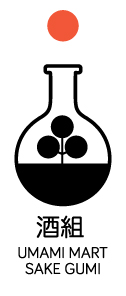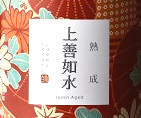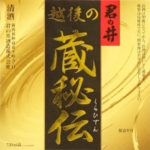 January sakes ship today for Sake Gumi, our monthly sake subscription club. If you like what's on deck here, you should join!
January sakes ship today for Sake Gumi, our monthly sake subscription club. If you like what's on deck here, you should join!
I love starting the new year fresh – drinking fruity, cold sakes that pair well with all the seafood and shellfish that is in season this time of year. For January's Sake Gumi selections, I wanted to kick off 2017 with four fresh and fruity sakes, especially after the last couple of months, where I featured rich and cozy bottles for the club.
So what makes a sake fruity?
The first thing to notice about fruity sakes is that they are typically
ginjos or
daiginjos. Both of these types of sakes use highly-polished rice, where the outer layers of the grain containing proteins and fats are removed. After brewers have removed these outer layers, what’s left is the delicate, starchy core, or
shinpaku. When making ginjos, rice must be polished down to at least 60% (meaning 40% of the outer layer is removed). When making daiginjos, rice must be polished down to at least 50%. Using highly-polished rice creates a final product that has more fruity, clean notes highlighting a natural sweetness reminiscent of fruit.
Another way to bring out fruitiness is to use certain strains of yeast. Ginjos typically use yeast #9, which in addition to providing a stable environment for fermentation, also enhances fruity and floral fragrances. I hope you will take note of the fruity bouquet of each sake this month. These aromas are thanks to the specific types of yeast the brewers are using.
We have one sake in level two that uses another technique to highlight fruitiness: the lack of pasteurization. When a sake is labeled
nama in the U.S. this means that it has skipped one of the two steps for pasteurization that sake usually goes through before and after maturation. When a sake skips one of the pasteurization processes, they tend to taste more fresh, lively, and fruity.
Drink a fruity sake as you would a fruity white wine, chilled to enhance their aromas and to savor their tartness and sweetness.
-Yoko
LEVEL 1: Introductory Membership (Two 300ml bottles)
 Jukusei Jozen Mizunogotoshi Junmai Ginjo
Jukusei Jozen Mizunogotoshi Junmai Ginjo
Shirataki Sake Brewery (Niigata, Japan)
Seimaibuai: 55%
SMV: +3
Brewed in Japan’s winter wonderland of Niigata Prefecture, this
junmai ginjo is all about stone fruit. I love the taste of juicy, tart cherries in this brew as well as its slightly tangy citrus rind finish thanks to a higher acidity value of 1.7. It is aged for a year at a lower temperature for smoothness. Bring out the fruitiness inherent in this sake by drinking it
chilled and pairing it with bold foods like
hot coppa,
soppressata, or
blue cheese.
 Takatenjin “Soul of the Sensei” Junmai Daiginjo
Takatenjin “Soul of the Sensei” Junmai Daiginjo
Doi Shuzo (Shizuoka, Japan)
Seimaibuai: 50%
SMV: +5
This daiginjo is as smooth as it gets. As far as fruit goes, it is full of honeydew melons with a hint of jasmine flower. With a creamy, long finish, this sake is a great beverage to savor on its own or with equally creamy, smooth morsels like
grilled oysters and
Fromage-Blanc style cheeses. The Doi Shuzo brewery named this sake after one of its previous
toji (head sake brewers), who developed the basis for this clean, dry sake that is simultaneously complex in its finish. Drink
chilled.
LEVEL 2: Premium Membership (Two 720ml bottles)
 Nechi Otokoyama Yukimizake Tokubetsu Honjozo
Nechi Otokoyama Yukimizake Tokubetsu Honjozo
Watanabe Sake Brewery (Niigata, Japan)
Seimaibuai: 60%
SMV: +4
Watanabe Sake Brewery is one of the few sake breweries that grows their rice on site. This allows them to use rice immediately after harvest, adding a dimension of brightness in the final product. This bottle of Yukimizake was part of a small batch production that was fermented at a lower temperature for longer. It also skips pasteurization before maturation. Both of these techniques results in a sake that is lively and full of bing cherries and orange rind. A relatively high acidity value of 1.8 makes this sake ideal to pair with rich, raw seafoods like
salmon and soft mild cheeses like
brie. Drink
chilled.
 Kiminoi “Emperor’s Well” Yamahai Junmai Ginjo
Kiminoi “Emperor’s Well” Yamahai Junmai Ginjo
Kiminoi Shuzo (Niigata, Japan)
Seimaibuai: 58%
SMV: +2
Contrary to the typical flavor profile of a yamahai, this sake finishes dry. But notice the overwhelming aroma of cherimoya, aka the fruit that Mark Twain called “the most delicious fruit known to men,” aka the custard apple. Like the cherimoya, this sake is rich in its mouthfeel - almost akin to caramel. Enjoy this sake
chilled alongside
fried calamari or
fried chicken.
 January sakes ship today for Sake Gumi, our monthly sake subscription club. If you like what's on deck here, you should join!
I love starting the new year fresh – drinking fruity, cold sakes that pair well with all the seafood and shellfish that is in season this time of year. For January's Sake Gumi selections, I wanted to kick off 2017 with four fresh and fruity sakes, especially after the last couple of months, where I featured rich and cozy bottles for the club.
So what makes a sake fruity?
The first thing to notice about fruity sakes is that they are typically ginjos or daiginjos. Both of these types of sakes use highly-polished rice, where the outer layers of the grain containing proteins and fats are removed. After brewers have removed these outer layers, what’s left is the delicate, starchy core, or shinpaku. When making ginjos, rice must be polished down to at least 60% (meaning 40% of the outer layer is removed). When making daiginjos, rice must be polished down to at least 50%. Using highly-polished rice creates a final product that has more fruity, clean notes highlighting a natural sweetness reminiscent of fruit.
Another way to bring out fruitiness is to use certain strains of yeast. Ginjos typically use yeast #9, which in addition to providing a stable environment for fermentation, also enhances fruity and floral fragrances. I hope you will take note of the fruity bouquet of each sake this month. These aromas are thanks to the specific types of yeast the brewers are using.
We have one sake in level two that uses another technique to highlight fruitiness: the lack of pasteurization. When a sake is labeled nama in the U.S. this means that it has skipped one of the two steps for pasteurization that sake usually goes through before and after maturation. When a sake skips one of the pasteurization processes, they tend to taste more fresh, lively, and fruity.
Drink a fruity sake as you would a fruity white wine, chilled to enhance their aromas and to savor their tartness and sweetness.
-Yoko
LEVEL 1: Introductory Membership (Two 300ml bottles)
January sakes ship today for Sake Gumi, our monthly sake subscription club. If you like what's on deck here, you should join!
I love starting the new year fresh – drinking fruity, cold sakes that pair well with all the seafood and shellfish that is in season this time of year. For January's Sake Gumi selections, I wanted to kick off 2017 with four fresh and fruity sakes, especially after the last couple of months, where I featured rich and cozy bottles for the club.
So what makes a sake fruity?
The first thing to notice about fruity sakes is that they are typically ginjos or daiginjos. Both of these types of sakes use highly-polished rice, where the outer layers of the grain containing proteins and fats are removed. After brewers have removed these outer layers, what’s left is the delicate, starchy core, or shinpaku. When making ginjos, rice must be polished down to at least 60% (meaning 40% of the outer layer is removed). When making daiginjos, rice must be polished down to at least 50%. Using highly-polished rice creates a final product that has more fruity, clean notes highlighting a natural sweetness reminiscent of fruit.
Another way to bring out fruitiness is to use certain strains of yeast. Ginjos typically use yeast #9, which in addition to providing a stable environment for fermentation, also enhances fruity and floral fragrances. I hope you will take note of the fruity bouquet of each sake this month. These aromas are thanks to the specific types of yeast the brewers are using.
We have one sake in level two that uses another technique to highlight fruitiness: the lack of pasteurization. When a sake is labeled nama in the U.S. this means that it has skipped one of the two steps for pasteurization that sake usually goes through before and after maturation. When a sake skips one of the pasteurization processes, they tend to taste more fresh, lively, and fruity.
Drink a fruity sake as you would a fruity white wine, chilled to enhance their aromas and to savor their tartness and sweetness.
-Yoko
LEVEL 1: Introductory Membership (Two 300ml bottles)
 Jukusei Jozen Mizunogotoshi Junmai Ginjo
Shirataki Sake Brewery (Niigata, Japan)
Seimaibuai: 55%
SMV: +3
Brewed in Japan’s winter wonderland of Niigata Prefecture, this junmai ginjo is all about stone fruit. I love the taste of juicy, tart cherries in this brew as well as its slightly tangy citrus rind finish thanks to a higher acidity value of 1.7. It is aged for a year at a lower temperature for smoothness. Bring out the fruitiness inherent in this sake by drinking it chilled and pairing it with bold foods like hot coppa, soppressata, or blue cheese.
Jukusei Jozen Mizunogotoshi Junmai Ginjo
Shirataki Sake Brewery (Niigata, Japan)
Seimaibuai: 55%
SMV: +3
Brewed in Japan’s winter wonderland of Niigata Prefecture, this junmai ginjo is all about stone fruit. I love the taste of juicy, tart cherries in this brew as well as its slightly tangy citrus rind finish thanks to a higher acidity value of 1.7. It is aged for a year at a lower temperature for smoothness. Bring out the fruitiness inherent in this sake by drinking it chilled and pairing it with bold foods like hot coppa, soppressata, or blue cheese.
 Takatenjin “Soul of the Sensei” Junmai Daiginjo
Doi Shuzo (Shizuoka, Japan)
Seimaibuai: 50%
SMV: +5
This daiginjo is as smooth as it gets. As far as fruit goes, it is full of honeydew melons with a hint of jasmine flower. With a creamy, long finish, this sake is a great beverage to savor on its own or with equally creamy, smooth morsels like grilled oysters and Fromage-Blanc style cheeses. The Doi Shuzo brewery named this sake after one of its previous toji (head sake brewers), who developed the basis for this clean, dry sake that is simultaneously complex in its finish. Drink chilled.
LEVEL 2: Premium Membership (Two 720ml bottles)
Takatenjin “Soul of the Sensei” Junmai Daiginjo
Doi Shuzo (Shizuoka, Japan)
Seimaibuai: 50%
SMV: +5
This daiginjo is as smooth as it gets. As far as fruit goes, it is full of honeydew melons with a hint of jasmine flower. With a creamy, long finish, this sake is a great beverage to savor on its own or with equally creamy, smooth morsels like grilled oysters and Fromage-Blanc style cheeses. The Doi Shuzo brewery named this sake after one of its previous toji (head sake brewers), who developed the basis for this clean, dry sake that is simultaneously complex in its finish. Drink chilled.
LEVEL 2: Premium Membership (Two 720ml bottles)
 Nechi Otokoyama Yukimizake Tokubetsu Honjozo
Watanabe Sake Brewery (Niigata, Japan)
Seimaibuai: 60%
SMV: +4
Watanabe Sake Brewery is one of the few sake breweries that grows their rice on site. This allows them to use rice immediately after harvest, adding a dimension of brightness in the final product. This bottle of Yukimizake was part of a small batch production that was fermented at a lower temperature for longer. It also skips pasteurization before maturation. Both of these techniques results in a sake that is lively and full of bing cherries and orange rind. A relatively high acidity value of 1.8 makes this sake ideal to pair with rich, raw seafoods like salmon and soft mild cheeses like brie. Drink chilled.
Nechi Otokoyama Yukimizake Tokubetsu Honjozo
Watanabe Sake Brewery (Niigata, Japan)
Seimaibuai: 60%
SMV: +4
Watanabe Sake Brewery is one of the few sake breweries that grows their rice on site. This allows them to use rice immediately after harvest, adding a dimension of brightness in the final product. This bottle of Yukimizake was part of a small batch production that was fermented at a lower temperature for longer. It also skips pasteurization before maturation. Both of these techniques results in a sake that is lively and full of bing cherries and orange rind. A relatively high acidity value of 1.8 makes this sake ideal to pair with rich, raw seafoods like salmon and soft mild cheeses like brie. Drink chilled.
 Kiminoi “Emperor’s Well” Yamahai Junmai Ginjo
Kiminoi Shuzo (Niigata, Japan)
Seimaibuai: 58%
SMV: +2
Contrary to the typical flavor profile of a yamahai, this sake finishes dry. But notice the overwhelming aroma of cherimoya, aka the fruit that Mark Twain called “the most delicious fruit known to men,” aka the custard apple. Like the cherimoya, this sake is rich in its mouthfeel - almost akin to caramel. Enjoy this sake chilled alongside fried calamari or fried chicken.
Kiminoi “Emperor’s Well” Yamahai Junmai Ginjo
Kiminoi Shuzo (Niigata, Japan)
Seimaibuai: 58%
SMV: +2
Contrary to the typical flavor profile of a yamahai, this sake finishes dry. But notice the overwhelming aroma of cherimoya, aka the fruit that Mark Twain called “the most delicious fruit known to men,” aka the custard apple. Like the cherimoya, this sake is rich in its mouthfeel - almost akin to caramel. Enjoy this sake chilled alongside fried calamari or fried chicken.




Comments (0)
There are no comments for this article. Be the first one to leave a message!